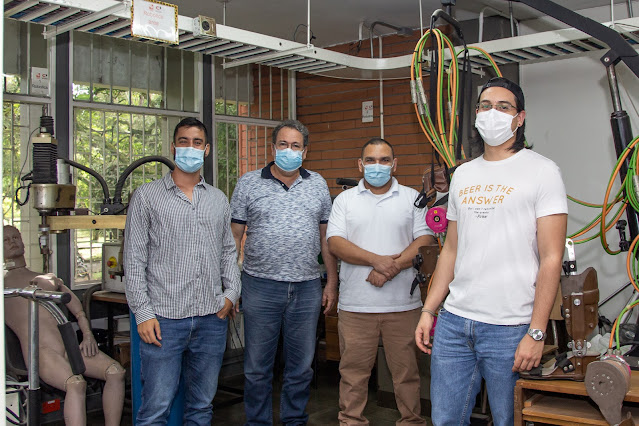In a laboratory in Spain, a lower.limb exoskeleton walks on a treadmill, using Colombian control algorithms — but this isn't science fiction, it is thanks to a group of researchers from the Faculty of Engineering of the Universidad del Valle (Univalle).
José Miguel Ramírez Scarpetta, a professor at Univalle and director of the Industrial Control Research Group, (GICI), said the control algorithms are part of his group's project to develop an exoskeleton that could help people in physical therapy relearn walking faster than with current treatments.
“In rehab now, learning to walk again can be a long road... the idea behind our project is that with an exoskeleton covering the lower body, the machine can automatically do almost all the physical effort initially, while the patient walks, assisted by the exoskeleton,” said Professor Ramírez, adding that gradually the patient can take on more of the load and the exoskeleton can adapt along with the patient.
In the robotics laboratory at Univalle in Cali, Colombia, the researchers showed off different parts of the experimental set-up. On one side sits the the RUVEM exoskeleton prototype, with its electrical connections. On the other, a harness is suspended above a treadmill where the patient can look at a big screen and simulate a virtual walk.
An Emerging Industry
The market for medical exoskeletons will be worth $1 billion in 2026 according to a market report published in November 2021.
But before this market matures, it needs to establish benchmarks to standardize the hardware and software it uses.
The project Eurobench, which provided funding for Univalle researchers for the tests in Spain, aims to create the first unified benchmarking framework for bipedal robotic systems in Europe.
This framework will allow companies and/or academic researchers to test the performance of their robots at any stage of development.
For now, Eurobench is concentrating mainly on bipedal machines such as exoskeletons, prosthetics and humanoids, but it intends to expand to other robotic technologies as well.
 |
| Photo: The GICI team. Credit: Juan Bacca |
A Connection Turns Into An Opportunity
The opportunity to test its algorithms came to Univalle through a connection between Spain and GICI researcher Sergey González Mejía.
Mejía did a stint of research at the Instituto Cajal, a Spanish research center specialized in neurobiology that is linked to the Higher Council for Scientific Research (CSIC).
When the opportunity came to apply and be part of the Eurobench project in Madrid, the Univalle team already had experience in exoskeleton control and they had a good shot at the AssistControl-H3 subproject.
"At Univalle, in the project we are developing, we have innovative results, such as our control algorithms," Mejía said, "The truth is that members of the team have already traveled to Madrid, Spain, where they developed a first set of preliminary tests, using their own algorithms and those of Technaid S.L. on the Exoesqueleto Exo-H3 and in in 2022, they will be back to do the definitive tests."
An International Collaboration
Professor Ramírez explained that collaboration with institutions and companies overseas is a big advantage for the professors and students of his group, by giving them visiblity and international research experience. The collaborators of Technaid S.L. also said it's a "win-win".
Elkin Mauricio Echeverri, Research and Development Engineer at Technaid S.L. said that the company considers the Universidad del Valle as a landmark institution for the training of high-level professionals in Colombia.
“Likewise, we know that Univalle, as it is known, stands out as a research entity at the national level, for this reason and because we maintain a close collaborative relationship with the GICI group, specialized in the domain of dynamic control systems, we consider that Univalle it was our best ally to participate in the Eurobench project of the Horizon 2020 program of the European Union,” Echeverri said.
Mr. Javier Orlando Roa Romero, Manager of Technaid S.L., stated that since its inception, the company has maintained a line of business in the field of technical aids for rehabilitation and functional compensation for movement disorders.

Comentarios
Publicar un comentario